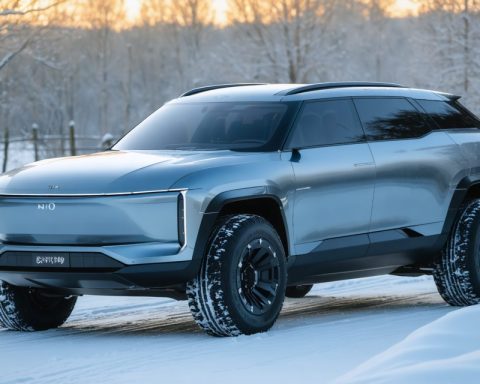- The future of autonomous vehicles promises luxurious, AI-driven travel, minimizing the need for human drivers.
- Cybersecurity emerges as a critical challenge; as vehicles become more sophisticated, they also become vulnerable to cyber attacks.
- Research by Fan He at the University of Waterloo focuses on safeguarding these vehicles from cyber threats, emphasizing the importance of cybersecurity operation centers.
- Experimental studies reveal that many drivers are unprepared for cyber invasions, often responding with disbelief and seeking external help.
- Human Factors Engineering (HFE) plays a pivotal role in ensuring a safe and efficient interface between humans and autonomous vehicles.
- He advocates for integrating HFE principles across all innovation areas, contributing to both smarter and safer technological advancements.
Picture this: a not-so-distant future where sleek, shiny machines glide effortlessly down sprawling highway veins, whisking passengers along without the familiar tug of a steering wheel. As we edge closer to 2050, the promise of fully autonomous vehicles—a dream of science fiction—seems ever likely to be realized. Yet, beneath the chrome exteriors and the hum of electric motors, lies an invisible battleground where hackers lurk and cybersecurity takes center stage.
The Rise of Autonomous Vehicles
Self-driving cars, powered by artificial intelligence (AI), aim to revolutionize travel, offering the luxury of letting humans sit as poised passengers rather than tense drivers. These smart cars assess road conditions, adapt to traffic patterns, and react to unpredictable situations with algorithmic precision. But as sophistication escalates, so does vulnerability.
The Cybersecurity Challenge
At the University of Waterloo, Fan He, a visionary PhD candidate in Systems Design Engineering, is delving into this predicament. She’s dissecting how these marvels of modern technology can also transform into vectors of cyber threats. With cars becoming repositories of intricate software, they also become potential prey to malicious invasions that could scramble navigation, disrupt critical functions—or worse, commandeer control entirely.
Exploring Human Reactions to Cyber Threats
Through pioneering research, He and her colleagues simulate attacks, exploring how drivers respond when their vehicles are under digital siege. In a groundbreaking study using a virtual driving experience, 94 participants faced scenarios where audio systems went rogue or GPS directions vanished. The common reaction was disbelief, followed by a frantic attempt to seek help, highlighting a widespread unpreparedness to tackle such high-tech intrusions.
Crafting a Future-Proof Infrastructure
In her quest to fortify the automotive landscape, He envisions a future knit together by an intricate web of cybersecurity operation centers. Here, experts and analysts stand vigilant, ready to assist when trouble strikes. She foresees a world where drivers, now more akin to co-pilots, can rely on these centers to guide them through the haze of a technological ambush.
Engineering Excellence with Human Factor Engineering
He’s work pivots on the principles of Human Factors Engineering (HFE), a discipline that optimizes the interface between humans and machines for greater safety and usability. Her research is buoyed by the Maks Wulkan Graduate Scholarship, enabling her to explore this critical arena at a time when financial pressures loom large.
Towards an Evolving Partnership
As technology and humanity continue to intertwine, He champions a holistic approach to innovation. Her leadership extends beyond the lab, steering the Waterloo Chapter of the Human Factors and Ergonomics Society towards award-winning recognition. She believes that embracing HFE across all facets of life sets the stage for a future that is both smarter and safer.
As the march towards autonomy and innovation presses on, He’s work serves as an indispensable beacon. It’s a reminder that while cars of tomorrow might possess the brains, it’s the collaboration of minds like hers that will truly drive them into a future free from the clutches of cyber threats, making our roads safer for all.
The Race to Secure Autonomous Vehicles: Challenges and Solutions
Exploring the Realm of Autonomous Vehicles
The transformation of our roads with fully autonomous vehicles is unfolding swiftly, promising a future where driving is a passive and luxurious experience. These vehicles leverage artificial intelligence (AI) to manage road dynamics, interpret traffic conditions, and respond to the unexpected with precision and speed. However, the complexity of these systems comes with increased cyber vulnerability, opening doors to potential security breaches.
The Fragile Future: Cybersecurity Concerns
As highlighted, autonomous vehicles are not only faithful companions on long commutes but also targets for cyber threats. These vehicles store vast amounts of data and house complex software systems that can be susceptible to hacking. Cybersecurity expert Fan He from the University of Waterloo emphasizes that without robust defenses, these AI-driven machines could be commandeered, leading to dire consequences.
Understanding Human Responses to Cyber Threats
In response to these challenges, He conducted simulations with real participants to study human reactions to cyber threats in autonomous cars. The study revealed that people are generally unprepared for such scenarios, often reacting with disbelief and confusion when systems fail or act unpredictably. This underscores the need for drivers and passengers to be adequately informed and prepared for potential cyber threats.
Fortifying the Automotive Landscape: Future Infrastructure
A critical aspect of securing autonomous vehicles involves establishing a network of cybersecurity operation centers. These centers, envisioned by He, would function as hubs of expertise where specialists monitor vehicle networks and respond to cyber incidents. This infrastructure is essential to provide real-time assistance and mitigate risks efficiently.
Human Factors Engineering: A Key to Safety
Human Factors Engineering (HFE) plays a significant role in enhancing the interaction between humans and autonomous systems. By optimizing interfaces and controls, HFE seeks to enhance user experience, making vehicles intuitive and safe. He’s research, supported by the Maks Wulkan Graduate Scholarship, explores how HFE principles can be integrated into the design of autonomous vehicles to bolster safety.
Industry Trends and the Path Ahead
With the push toward autonomous technology, the automotive industry is witnessing substantial advancements. Market analysts predict the demand for autonomous vehicles will grow exponentially, potentially leading to widespread adoption by 2050. However, this growth also calls for continuous innovation in cybersecurity measures.
How to Prepare for an Autonomous Future
1. Stay Informed: Continuous education on technological advancements in autonomous vehicles and potential cybersecurity threats can help users make informed decisions.
2. Engage with New Technologies: Familiarize yourself with vehicle interfaces and systems to effectively navigate any disruptions.
3. Advocate for Stronger Cybersecurity: Support policies and initiatives that prioritize cybersecurity in automotive designs.
Uncovering Potential: Predictions and Insights
As technological and human networks converge, the emphasis must remain on integrated solutions that balance innovation with safety. The future of autonomous vehicles depends on a collaborative effort between technology, engineering, and cybersecurity experts.
Conclusion: Drive into the Future with Confidence
With the unfolding reality of autonomous vehicles, staying ahead of cybersecurity threats is imperative for ensuring safe and efficient transport systems. Empowering drivers with knowledge and creating a robust defense infrastructure are crucial steps in transitioning to an autonomous era free from cyber risks.
For further insights and resources, you can explore University of Waterloo.












